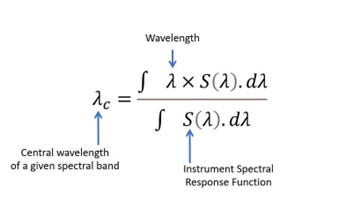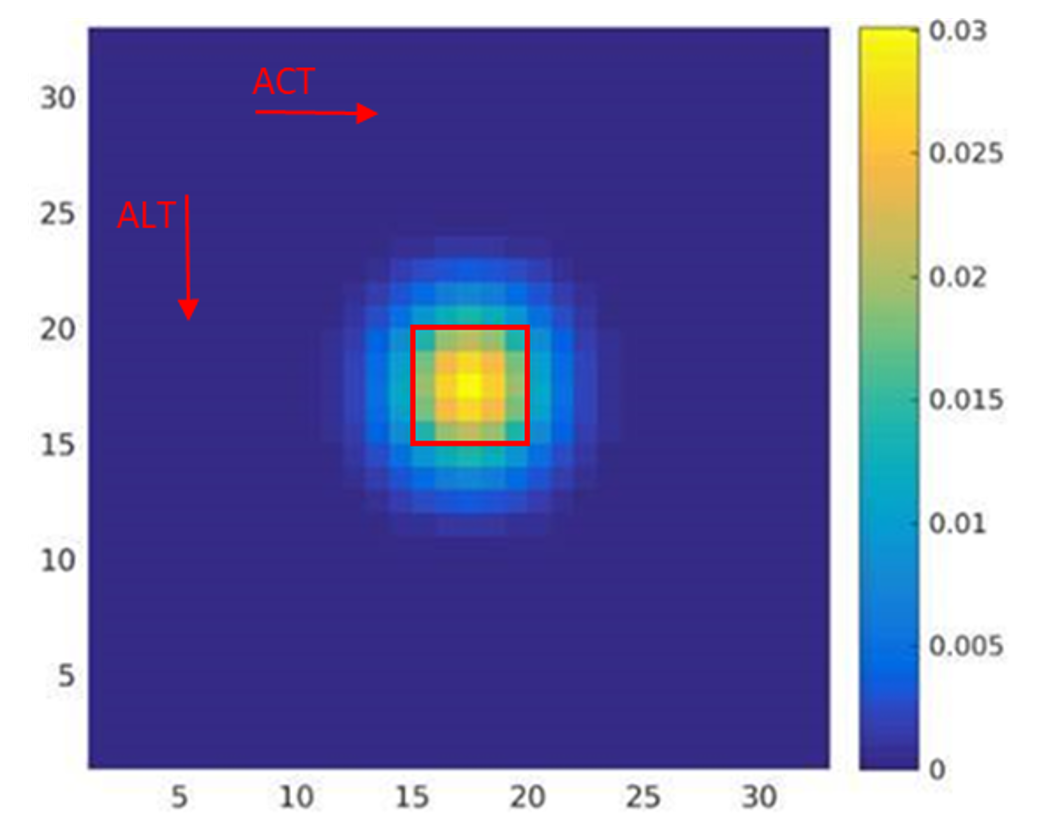The design of the MultiSpectral Instrument (MSI) on-board SENTINEL-2 has been driven by the requirement for large swath high geometrical and spectral performance of the measurements.
The MSI measures the Earth's reflected radiance in 13 spectral bands from VNIR to SWIR (Table 1). All the details about the measured spectral responses for each bands are given in the Sentinel-2 Spectral Response Functions (S2-SRF) document.
NOTE: The Bandwidth (nm) is measured at Full Width Half Maximum (FWHM). The central wavelength is the barycenter of the spectral response function, not taking into account the solar irradiance:

| S2A | S2B | ||||
| Band Number | Central wavelength (nm) | Bandwidth (nm) | Central wavelength (nm) | Bandwidth (nm) | Spatial resolution (m) |
|
1 |
442.7 |
20 |
442.3 |
20 |
60 |
|
2 |
492.7 |
65 |
492.3 |
65 |
10 |
|
3 |
559.8 |
35 |
558.9 |
35 |
10 |
|
4 |
664.6 |
30 |
664.9 |
31 |
10 |
|
5 |
704.1 |
14 |
703.8 |
15 |
20 |
|
6 |
740.5 |
14 |
739.1 |
13 |
20 |
|
7 |
782.8 |
19 |
779.7 |
19 |
20 |
|
8 |
832.8 |
105 |
832.9 |
104 |
10 |
|
8a |
864.7 |
21 |
864.0 |
21 |
20 |
|
9 |
945.1 |
19 |
943.2 |
20 |
60 |
|
10 |
1373.5 |
29 |
1376.9 |
29 |
60 |
|
11 |
1613.7 |
90 |
1610.4 |
94 |
20 |
|
12 |
2202.4 |
174 |
2185.7 |
184 |
20 |
Figure 1 shows the S2A spectral response functions (SRF) and transmission due to vertical column Water Vapour (WV) absorption for subarctic winter atmosphere (light blue, lowest WV content) and tropical atmosphere (darker blue, highest WV content). WV transmission data comes from MODTRAN.
Figure 1: SRF and transmission due to vertical column WV absorption
MSI Description
The MSI is designed and built by Airbus Defence and Space, France, and is based on a push-broom concept (Figure 2).
MSI instrument features
- A Three-Mirror Anastigmat (TMA) telescope with a pupil diameter equivalent to 150 mm, isostatically mounted on the platform to minimise thermo-elastic distortions. The optical design has been optimised to achieve state-of-the-art imaging quality across its very wide field of view. Its 290 km swath width is a larger swath than previous multi-spectral optical missions such as SPOT and LANDSAT. The telescope structure and the mirrors are made of silicon carbide, which provides a very high optical stability to mass ratio and minimises thermal deformation.
- Two focal planes based on:
- monolithic Complementary Metal Oxide Semiconductor (CMOS) detectors for VNIR
- mercury-cadmium-telluride (MCT) detectors hybridised on a CMOS read-out circuit for SWIR (the SWIR focal plane is passively thermo-controlled at temperatures below 195 K).
- A dichroic VNIR/SWIR beam splitter. Spectral separation in the various bands is provided by stripe filters mounted on top of the detectors.
- Two distinct arrays of 12 detectors mounted on each focal plane covering VNIR and SWIR channels respectively. The 12 detectors on each focal plane are in a staggered configuration to cover the entire field of view.
- A full-field and full-pupil on-board diffuser for radiometric calibration to guarantee high-quality radiometric performance.
- A shutter mechanism preventing the instrument from direct illumination by the sun. This mechanism is also used as a calibration device by collecting the sunlight after reflection by a diffuser.
Figure 2: The MultiSpectral Instrument (Airbus Defence and Space)
Figure 3: MSI Internal Configuration
The 12 detectors on each focal plane are mounted in a staggered formation (Figure 4) to cover the whole 20.6o instrument field of view, resulting in a compound swath width of 290 km on the ground track. As illustrated in the figure below, due to the staggered positioning of the detectors on the focal planes, a parallax angle between the two alternating odd and even clusters of detectors is induced in the measurements, resulting in a shift along track of approximately 46 km (maximum) inter-detector. Likewise, the hardware design of both the VNIR and SWIR detectors imposes a relative displacement of each spectral channel sensor within the detector resulting in an inter-band measurement parallax amounting to a maximum along track displacement of approximately 14 km.
Figure 4: Staggered Detector Configuration and Inter-Detector / Inter-Band Parallax Angles (parallax figures derived from MSI instrument documentation)
Due to the particular geometrical layout of the focal plane, each spectral band of the MSI observes the ground surface at different times.
| Inter-band Pair | Temporal offset between bands (seconds) |
| B08 / B02 | 0.264 |
| B03 / B08 | 0.264 |
| B03 / B02 | 0.527 |
| B10 / B03 | 0.324 |
| B10 / B02 | 0.851 |
| B04 / B10 | 0.154 |
| B04 / B02 | 1.005 |
| B05 / B04 | 0.264 |
| B05 / B02 | 1.269 |
| B11 / B05 | 0.199 |
| B11 / B02 | 1.468 |
| B06 / B11 | 0.057 |
| B06 / B02 | 1.525 |
| B07 / B06 | 0.265 |
| B07 / B02 | 1.790 |
| B8a / B07 | 0.265 |
| B8a / B02 | 2.055 |
| B12 / B8a | 0.030 |
| B12 / B02 | 2.085 |
| B01 / B12 | 0.229 |
| B01 / B02 | 2.314 |
| B09 / B01 | 0.271 |
| B09 / B02 | 2.586 |
For bathymetry purposes, please note that a new methodology to precisely compute a time-lag in between image bands and per detector for L1C and higher-level products was derived based on L1B level products. For more details, please refer to Binet et al. paper.
Point Spread Functions
The provided Point Spread Functions (PSF) have been computed approximatively from MTF measurements at fe/2 ALT and ACT values (according to January 2022 values) and using a Gaussian modelling.
The PSF correspond to L1B products (in focal plane geometry, after binning), for S2A and S2B, for all bands, except B10 which does not see the ground (Water Vapor band).
These PSF are normalized (sum of coefficients is 1), subsampling factor is 5, and center pixel is at coordinates (17,17) in the 33*33 provided matrix.
The footprint of the Pixel, and the Along Track (ALT) and Across Track (ACT) directions are described in the graph below representing S2B PSF for B05.

Figure 5: S2 PSF
You can find more details about the PSF per band in the following documents for S2A and S2B.